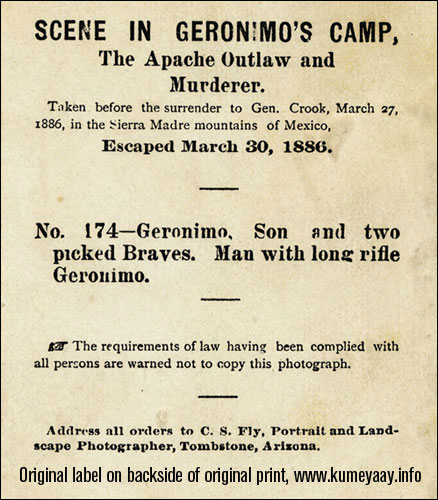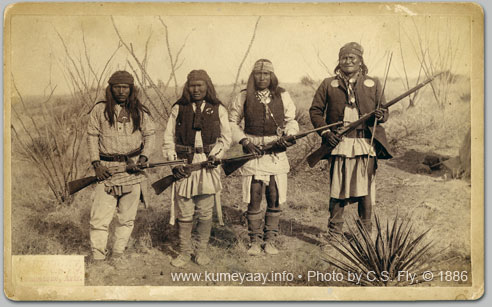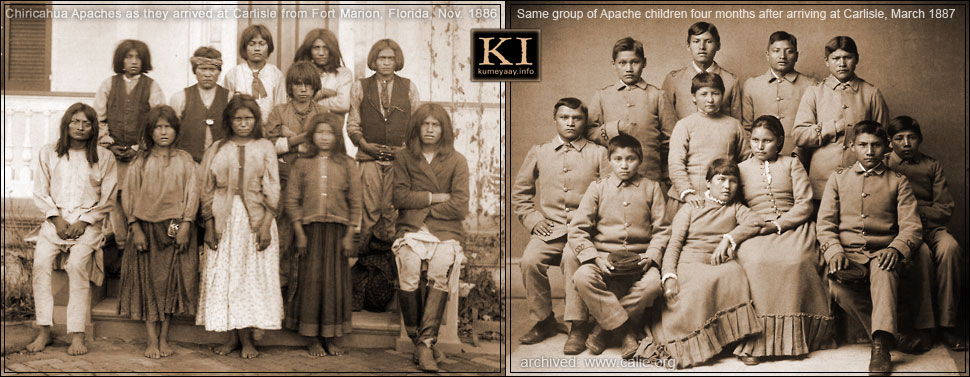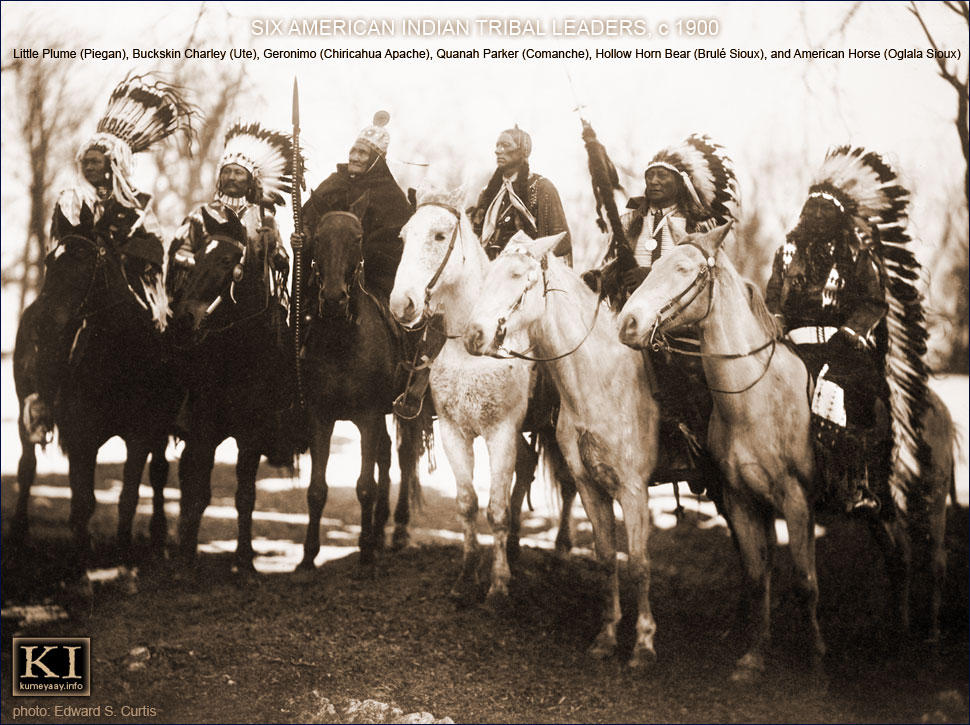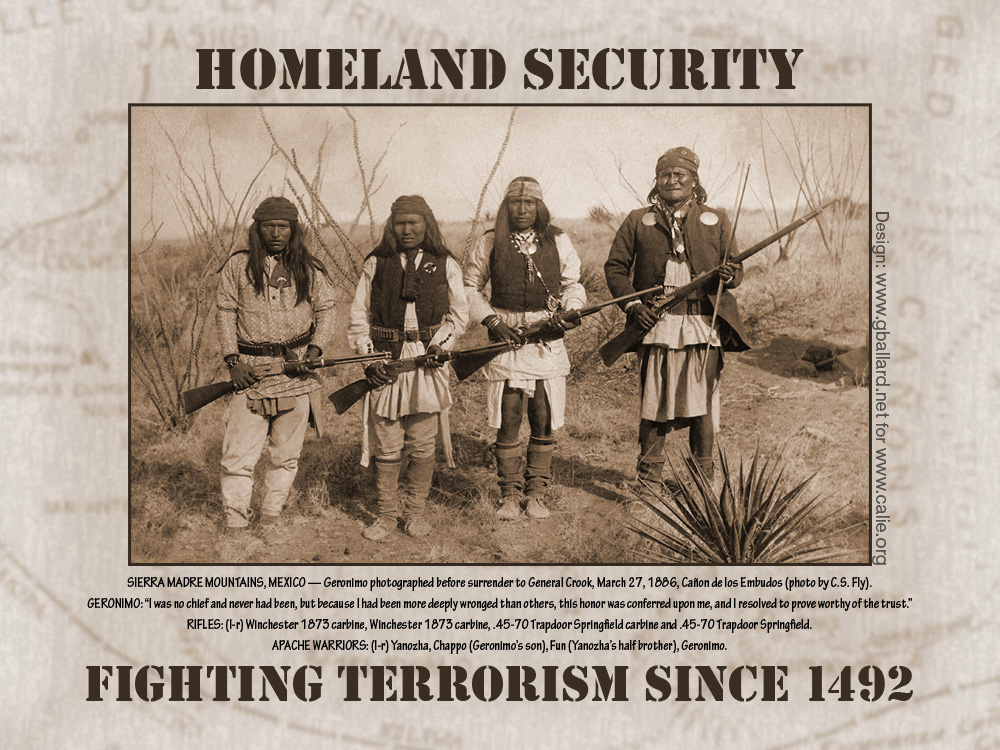
TRIBAL HOMELAND SECURITY HEROS
Español | 中文 | 日本 | Française | Deutsch | 한국어 | Россию | پارس
AMERICAN INDIANS FIGHTING TERRORISM IN AMERICA
TRIBAL SECURITY EXPERTS, USA — Here's a look into these classic Indian fighter headlines comparing an editorial opinion about 21st century terrorism in America with a late 19th century Native American Indian war photograph by C.S. Fly picturing Chief Geronimo standing with Apache American Indian warriors holding their military rifles in a southwestern desert landscape.
The poster really makes a person Stop & Think (I hope)...
GERONIMO RESEARCH PORTALI am posting some of the Geronimo research I used in the creation of our Homeland Security poster BECAUSE it is important to know something about the indigenous American tribal histories to better understand the meaning behind this POWERFUL ARTISTIC STATEMENT. And Geronimo is a lot more interesting to talk about when we know a few historical facts about his life — how his small Apache band arrived at that moment in American history, what CRIMES AGAINST HUMANITY the Mexican and United States governments were committing against the Apache indigenous people (the ETHNIC CLEANSING taking place in the 1800s), and where Geronimo's Apache tribe is today at the turn of the 21st century. Therefore, my essay explores the ultra-famous Native American Indian warrior/chief/hero Geronimo, and includes Apache history briefs, tribal websites, historical war records, professionally restored vintage photographs with extended photo captions and background information. |
|||
|
OPERATION GERONIMO: "Geronimo-E KIA." First — with President Barack Obama's successful U.S. Navy SEAL covert military operation code name "GERONIMO" that assassinated 9/11 mastermind Osama bin Laden in Pakistan, May 2, 2011 — JUSTICE WAS DONE — and that point is hard for any person to argue otherwise. LONG HISTORY OF HEROIC MILITARY SERVICE FIGHTING FOR AMERICA: The American people have good reasons to be proud of their indigenous war heros, including the 20-plus Native American Indians that received the United States Congressional MEDAL OF HONOR:
|
|||
|
CULTURAL DISCLAIMER — WAR HEROS or TERRORISTS? The important 1886 historical American war photograph of Geronimo and its headline connotation to "Homeland Security" and "Terrorism" has extreme deep-seated and inter-generational significance to the native indigenous peoples of our great country, the United States of America, USA. Many brave Indian warriors, many beautiful Indian women and grandmothers, and many innocent Indian children did not survive the post European contact military incursions by Spanish-Mexican-British-French-American government soldiers and civilian militias that overran and blatantly stole their ancestral homelands, decimated their populations and literally sought to exterminate them from the Earth. I may add: Some of the American Indian tribes, like the Kumeyaay, for example, have been traced back some 12,000 years in what is now known as Southern California and northern Mexico — that's 600 generations the Kumeyaay have lived in America! At best, a non-Indian can claim 26 generations in America, and that's if his or her ancestor came here on the Niña, the Pinta, or the Santa Maria with Christopher Columbus in 1492. RESEARCH POST-CONTACT AMERICAN INDIAN HISTORY: |
|||
|
GERONIMO POSTER IMAGE SCANNED FROM ORIGINAL 1886 PHOTO — with label on backside of original print: The Geronimo photograph used in our "Homeland Security" poster was scanned from an original C.S. Fly photographic cabinet card print (circa 1886). Below is a scan of the original 1800s copyright label attached to the backside of the Geronimo cabinet card used to make the tribal security poster. This card in a Web auction sold for over $10,000 USD.
As evident in the photographer's original 1886 studio caption, Geronimo aka "Goyaałé" (Geronimo's Indian name) was a very controversial Native American Indian warrior...RESEARCH Geronimo's wikipedia.org page, too, for additional information to see through the propaganda and form an opinion based on the historical record — the U.S. government's sanctioned ethnic cleansing of the indigenous population and Geronimo's resistance efforts against highly-superior military forces:
|
|||
|
MODERN 21st CENTURY PHOTO CAPTION: Sierra Madre Mountains, Mexico, March 27, 1886 — Apache American Indian warrior "Geronimo" and three well-armed tribal war heros posed for a photograph in their Indian camp holding late 19th century military rifles during a period of extended surrender negotiations with United States Army General George Crook. APACHE WARRIORS PICTURED: (l-r) Yanozha, Chappo (Geronimo's son), Fun (Yanozha's half brother), and Geronimo at the Cañon de los Embudos (source: "The Apache Diaries, a Father-Son Journey" by Grenville Goodwin & Neil Goodwin). The notorious Apache warriors, pictured here near the end of their resistance efforts at the Cañon de los Embudos (Canyon of the Funnels), about twenty miles south of the US-Mexican border, were to finally surrender to General Nelson A. Miles in Skeleton Canyon on September 4, 1886 (some six months after this historic photo was taken). Geronimo's efforts in successfully resisting government forces are noted by historians as being the last significant guerrilla warfare actions by Indians against the United States. ARE THESE GERONIMO'S ACTUAL INDIAN RIFLES? Many historians believe these are the Apaches' actual firearms (not prop guns given to them to make the scene more interesting). During my research, one such history buff noted he saw other historic period war photographs of Geronimo's warriors holding the same rifles. HISTORIC INFORMATION ABOUT GERONIMO'S 1800s MILITARY CALVARY RIFLES: APACHE WEAPONS PICTURED: (l-r) Winchester 1873 carbine, Winchester 1873 carbine, .45-70 Trapdoor Springfield carbine and a .45-70 Trapdoor Springfield (source: "Guns of the Old West: An Illustrated Guide" by Charles Edward Chapel). The thin rods Geronimo is holding are likely cleaning rods that would have been attached in a "X" as a field rifle rest to provide a "V" crotch for steadying the rifle for long-range shots — so it appears Geronimo was the sharpshooter with the long rifle. |
|||
|
FROM GERONIMO'S APACHE TRIBE 2011:
WEBSITE www.chiricahua-apache.com ABOUT GERONIMO FROM HIS PEOPLE'S OFFICIAL WEBSITE: www.chiricahua-apache.com website is under development by the Chiricahua Apache Prisoner of War Committee, which consists of direct descendants of Chiricahua Apache prisoners of war. We all are enrolled members of the Mescalero Apache Tribe of New Mexico and our committee is authorized by the Mescalero Apache Tribe’s President, Vice President, and Tribal Council — WATCH THEIR VIDEO (this video is currently on view at the National Museum of the American Indian in Washington DC). Another on-line Geronimo tribal study resource: HARLYN GERONIMO INTERVIEW 2006 (Geronimo's great grandson). RECOMMENDED BOOKS: "The Apache Diaries: A Father-Son Journey" by Grenville Goodwin and Neil Goodwin, University of Nebraska Press 2000 "Geronimo: His Own Story: The Autobiography of a Great Patriot Warrior" by Geronimo, S. M. Barrett, Frederick W. Turner,Plume; Rev Sub edition (1996).
Famous Geronimo quote: “I was no chief and never had been, but because I had been more deeply wronged than others, this honor was conferred upon me, and I resolved to prove worthy of the trust. "Late one afternoon when returning from town we were met by a few women and children who told us that Mexican troops from some other town had attacked our camp, killed all the warriors of the guard, captured all our ponies, secured our arms, destroyed our supplies, and killed many of our women and children...when all were counted, I found that my aged mother, my young wife, and my three small children were among the slain." Excerpts from Geronimo's biography: Geronimo: His own Story. |
|||
| AMERICAN INDIAN HISTORY 101:
After the Indian wars, 19th century government mentality:
HISTORICAL RESEARCH WEB PORTAL American Indian Schools, circa 1850-2011...
Note: Chiricahua Apache children pictured above are of Geronimo's tribe. The first image was photographed in November of 1886 about two months after Geronimo surrendered. Carlisle school photos by John N. Choate courtesy of National Museum of the American Indian, Washington D.C. (Study Resource). CARLISLE INDIAN BOARDING SCHOOL — Chiricahua Apache children (left) posed for a group photograph as they arrived at the Carlisle school from Fort Marion in November, 1886. And (right) four months later in March, 1887, the same children pictured wearing their Carlisle military-type school uniforms. With the founding of the Carlisle Indian Industrial School in 1879 the U.S. government launched an effort at what is now recognized as CULTURAL GENOCIDE whereas Indian children were taken away from their families and placed into boarding schools for three or more years.... Can you imagine foreign soldiers entering YOUR community, YOUR church, YOUR home and forcibly taking YOUR children or YOUR brothers and sisters away and putting them into so-called "boarding schools" to BRAINWASH them and eradicate YOUR native language, culture and religion from THEIR young minds? How greatly would you have hoped your statesmen and warriors would have fought to protect your children's future?
SIX FAMOUS AMERICAN INDIAN LEADERS ON HORSEBACK (l-r) — Little Plume (Piegan), Buckskin Charley (Ute), Geronimo (Chiricahua Apache), Quanah Parker (Comanche), Hollow Horn Bear (Brulé Sioux), and American Horse (Oglala Sioux). Photo: Edward S. Curtis, circa 1900. |
GREAT ONLINE HISTORICAL ARTICLES ABOUT GERONIMO:
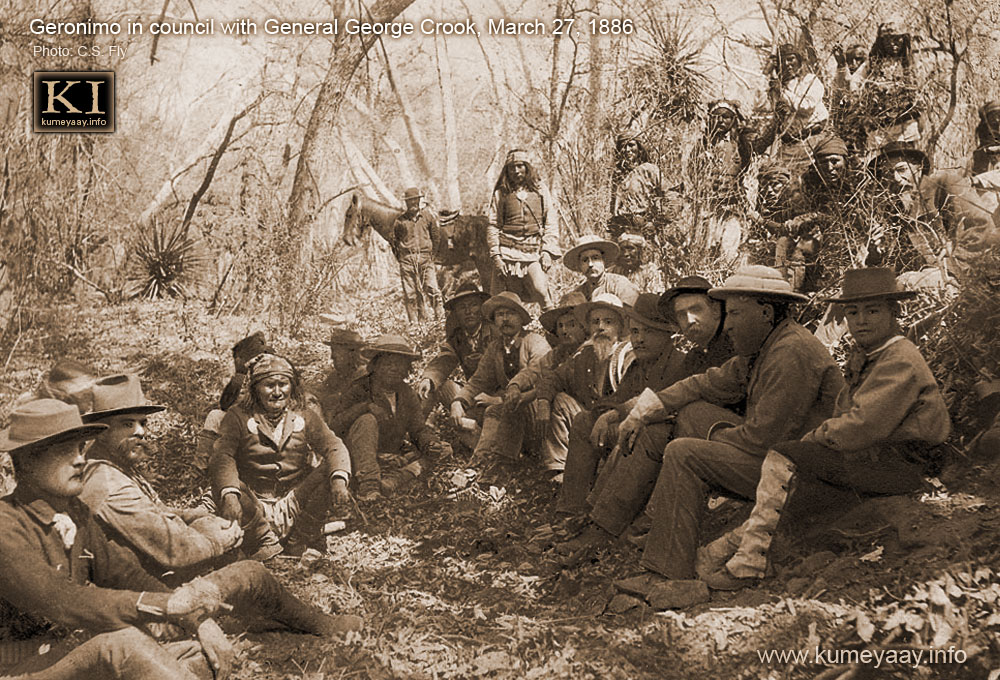
Photo caption: Chief Geronimo pictured in council with General George Crook, March 27, 1886 (photo by C.S. Fly). Some of the faces in this image appear to have been "worked on"...it's hard to guess when this photo retouching was done, but most likely it is was done on an original print long before Adobe Photoshop® was invented.
JAMES HURST:
Here is an excerpt from a great Web article by James Hurst about some historical facts that eventually led to Geronimo's surrender in Skeleton Canyon around the time when the famous Geronimo picture was taken in 1886 (please see the link for the complete article):
- "On May 17, 1885, Mangus (son of Mangus Colorado), Chihuahua, Nachite, old Nana, the shaman Geronimo, and their followers fled the San Carlos reservation in Arizona in an attempt to regain the freedom they had known before the reservation system was instituted by the United States government.
"The restrictions of reservation life were difficult for these semi-nomads, and they longed for the openness of the land the Spaniards had called Apacheria.
"Although the Chiracahuas could not have foreseen it, this was to be their last attempt to recapture the old ways that many of their cousins had already forsaken.
"The "renegades" or "hostiles" as they were called, consisted of 35 men, eight boys, and 101 women and children. They would occupy the attention of 5,000 troops, 500 Indian auxiliaries, and an unknown number of civilians...".
BARBARA PING:
- SOURCE and great collection of Geronimo pictures:
Exhausted, and hopelessly out numbered, Geronimo surrendered on March 27, 1886 at Cañon de Los Embudos in Sonora, Mexico. His band consisted of a handful of warriors, women, and children. Also found was a young white boy named Jimmy "Santiago" McKinn, that the Indians had kidnapped some six months earlier in September. The "rescued" boy had become so assimilated to the Apache lifestyle, he cried when he was forced to return to his parents.
Also traveling with General Crook was the photographer, C.S. Fly of Tombstone fame. After the bands capture, he was able to take some of the most famous photographs in U.S. history.
The soldiers gathered the group and began the trek to Fort Bowie, Arizona. However, near the border, Geronimo, fearing that they would be murdered once they crossed into U.S. territory, bolted with Chief Naiche, 11 warriors, and a few women and boys, who were able to escape back into the Sierra Madra. As a result, Brigadier General Nelson A. Miles replaced Crook as commander on April 2, 1886.
At a conference on September 3, 1886, at Skeleton Canyon in Arizona, General Miles induced Geronimo to surrender once again, promising him that, after an indefinite exile in Florida, he and his followers would be permitted to return to Arizona.
The promise was never kept. Geronimo and his fellow prisoners were shipped by box-car to Florida for imprisonment and put to hard labor.
It was May 1887 before Geronimo saw his family. Several years later, in 1894, he was moved to Fort Sill in Oklahoma Territory where he attempted to “fit in.” He farmed and joined the Dutch Reformed Church, which expelled him because of his inability to resist gambling.
As years passed, stories of Geronimo's warrior ferocity made him into a legend that fascinated non-Indians and Indians alike. As a result, he appeared at numerous fairs, selling souvenirs and photographs of himself. In 1905 he was quite the sensation when he appeared in President Theodore Roosevelt's inaugural parade. Geronimo dictated his memoirs, published in 1906 as Geronimo's Story of His Life.
Never having seen his homeland of Arizona again, Geronimo died of pneumonia on February 17, 1909 and was buried in the Apache cemetery at Fort Sill, Oklahoma....
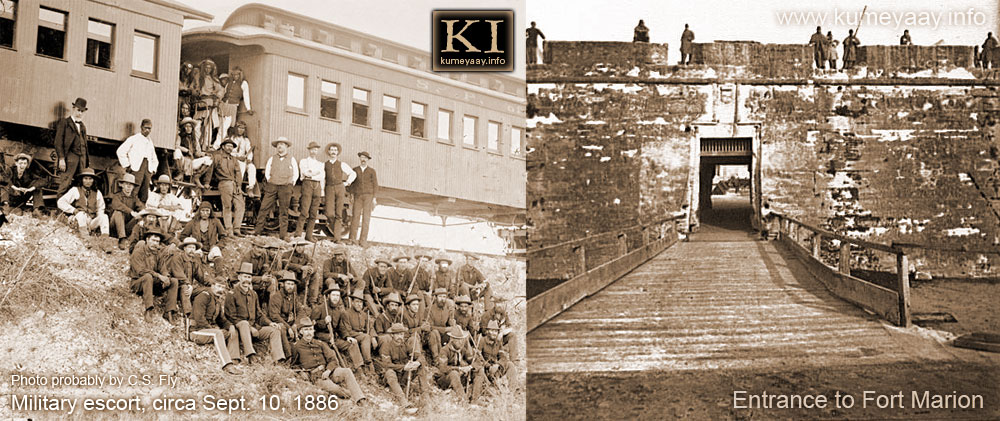
PRISONERS OF WAR (POW) — Geronimo's heavily-armed military escort guard posed for a photograph outside the POW train, circa September 10, 1886, near Nueces River, Texas. (Right) Entrance to Fort Marion, circa 1880s. In 1886, the United States sent over 500 Chiricahua Apache men, women, and children from Arizona to Florida as prisoners of war....
![]()
ABOUT THE GERONIMO WAR PHOTOGRAPHER:
Camillus S. “Buck” Fly was a famous photojournalist of the late 1800s, and is best known for his pictures of Geronimo in 1886 at the end of the American Apache War. Buck Fly was born in California in 1850 and died in 1901. Buck Fly's photo studio was located in Tombstone, Arizona, and some researchers have said "The Gunfight at the OK Corral" is more accurately called the "Gunfight in the Alley by Fly's Photography Studio."
See the large SMITHSONIAN INSTITUTION C.S. FLY PHOTO COLLECTION, Fly took a lot photos during this period.
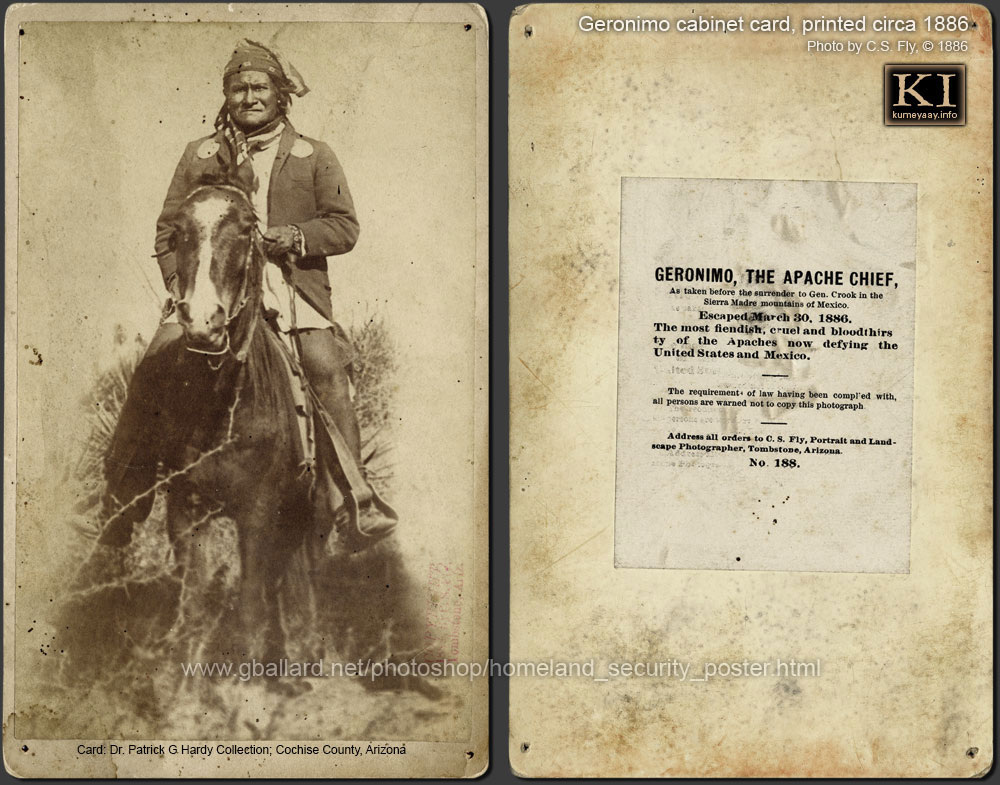
Historical Photographic Card: Dr. Patrick G Hardy Collection; Cochise County, Arizona
Professional digital scan of famous C.S. Fly photograph printed on cabinet card, circa 1886. Geronimo on horse, label on backside translation reads:
- GERONIMO, THE APACHE CHIEF, As taken before the surrender to Gen. Crook in the Sierra Madre mountains of Mexico.
- Escaped March 30, 1886.
- The most fiendish, cruel and bloodthirsty of the Apaches now defying the United States and Mexico.
- The requirement of law having been complied with, all persons are warned not to copy this photograph.
Address all orders to C. S. Fly, Portrait and Landscape Photographer, Tombstone, Arizona.- No. 188.
- Escaped March 30, 1886.
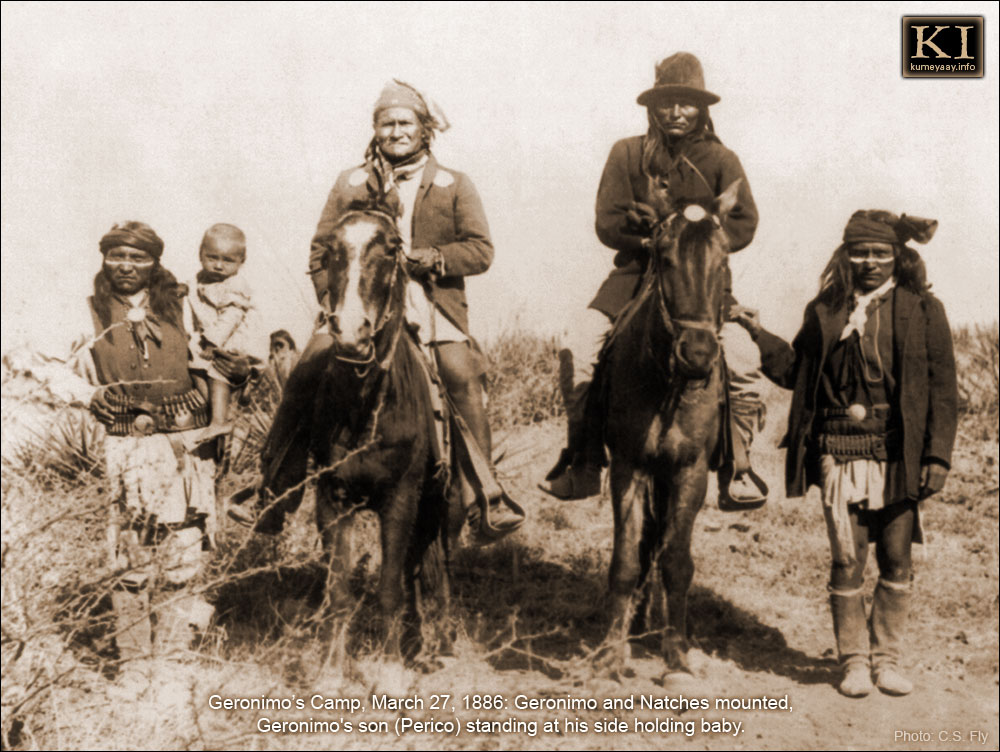
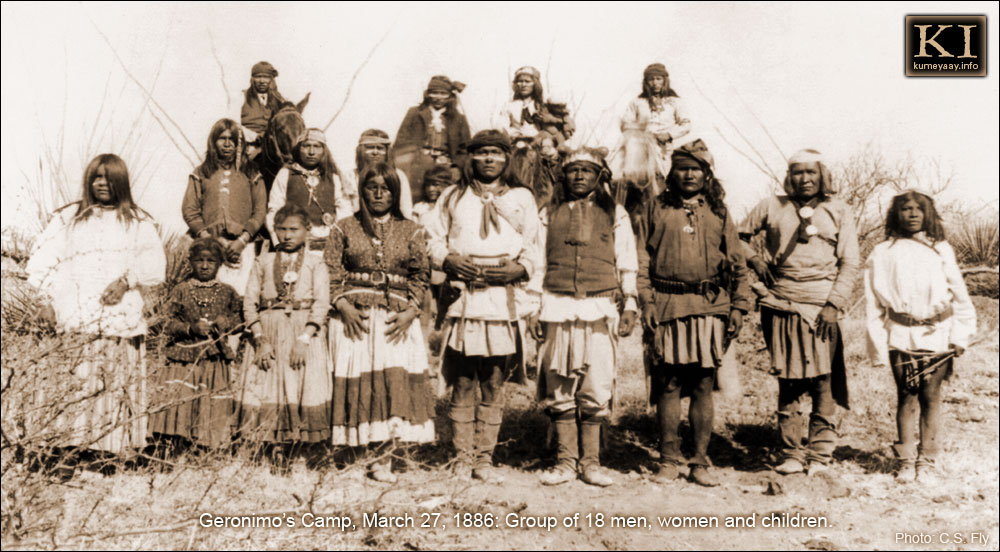
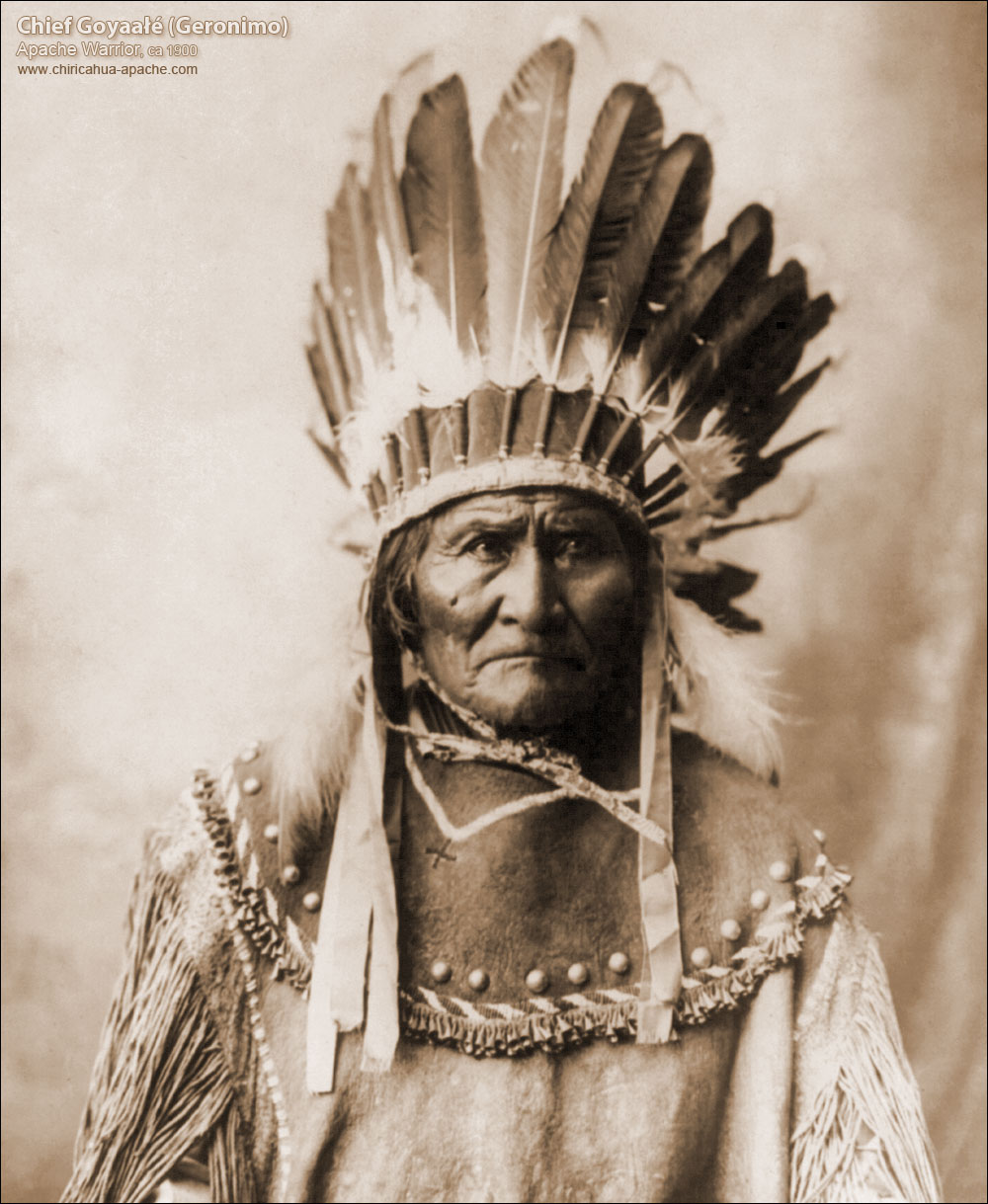
At about the age of 70, Chief Goyaaé (Geronimo, also spelled Goyathlay and Goyahkla) pictured in this high resolution ultra famous Mescalero-Chiricahua Apache portrait wearing eagle feathers in his tribal headdress and fine traditional American regalia. Photo circa 1900, photographer unknown, digital restoration by G. BALLARD.
My on-line research indicates Geronimo was still imprisoned at Fort Sill, Oklahoma when he posed for this portrait.
After taking Geronimo into custody in 1886, the US government never permitted Geronimo to visit or see his beloved tribal homelands again — an area now owned by the United States government and known as the Gila National Forest in New Mexico — a designated Wilderness Area roughly 1.5 million acres of the most beautiful countryside on Earth.
Geronimo died in prison at Fort Sill, Oklahoma Feb. 17, 1909, and was buried in the Fort Sill Apache Prisoner of War Cemetery after 23 years of captivity, but Geronimo's story doesn't stop there.
Did President Bush's grandfather, Prescott Bush, and some of his buddies at Yale dig up the grave of Apache chief Geronimo and steal his skull for their Skull and Bones society back in 1917? Harlyn Geronimo (Geronimo's great grandson) thinks so and has sued Skull and Bones, the secret society at Yale University...
FAMOUS GERONIMO Quotes:
- Geronimo:
"No guns, no bullets could ever kill me. That was my power...Now my time is over."
Geronimo:
"I was born on the prairies where the wind blew free and there was nothing to break the light of the sun. I was born where there were no enclosures.”
Geronimo:
"With all this land, why is there no room for the Apache? Why does the White-Eye want all land?"
Al Sieber, Chief of Scouts:
"There's two dead women there...and two little kids. They scalped them all, all four of 'em. Bounty hunters. The government down here pays 200 pesos a head for men, 100 for women and 50 for those kids. They kill any Indian and then claim they are Apache. I don't see how any man can sink so low. Must be Texans...the lowest form of white man there is."
1st Lieutenant Charles B. Gatewood:
"The Apache go where the best fight is. It's a moral value once you understand it."
Geronimo:
"I cannot think that we are useless or God would not have created us. There is one God looking down on us all. We are all the children of one God. The sun, the darkness, the winds are all listening to what we have to say.”
Geronimo:
"Believing that in a wise way it is good to go to church, and that associating with Christians would improve my character, I have adopted the Christian religion...I am not ashamed to be a Christian...I have advised all of my people who are not Christians, to study that religion, because it seems to me the best religion in enabling one to live right.”
2nd Lt. Britton Davis:
"As he handed over his weapons, Geronimo simply said: 'Once I moved about like the wind. Now I surrender and that is all.'"
SPECIAL THANKS:
I received some of my detailed facts and information about Geronimo's historical Indian weapons on the best ANTIQUE RIFLE FORUM on the Internet — click on the forum logo below and check out our discussion about the rifles pictured in this famous Geronimo photograph — very special thanks to CW Howard, Recon, pikeman, Joseph E. Kissel, johnhamilton, Bruce in Iowa, Larry, Jeffanderson, Nord, Marty, im4guns, hrf, Marty, man504, McCord, hmaag for their great info....

READ the interesting discussion about the Apache rifles by vintage firearms experts and gun enthusiasts on AntiqueGuns.com.
OLD MEXICO INDIAN MAP:
The background image on this poster is an old antique Indian map of the U.S.-Mexico border region that still showed some of the original Indian names of the high desert regions of Baja California Indian lands.
BUY FINE ART REPRINTS FOR SALE:
G. BALLARD design studio can make commercial-grade fine-art poster prints of this poster for sale. If you want information about how to buy a high-end archival poster print, please EMAIL G. BALLARD.
RECOMMENDED PRINT SIZES & PRICES:
14x18 at $75
20x24" at $125
24x32" at $175
44x52" (call)
plus shipping and handling and any applicable taxes.
CUSTOM LAYOUT: I can rework the layout to fit existing frame sizes.
FINEST MASTER PRINT QUALITY: Using the best high-end, museum-grade custom framing materials will only enhance the impressive professional quality of these master prints — I personally guarantee the aesthetic print quality will hold its own in any level of executive office, home, museum or tribal hall environment.
The below detail is how the "Actual Pixels" look on an 20x24-inch print — archival heat mounting is available on black Gator board, or museum-grade framing with UV non-glare glass.
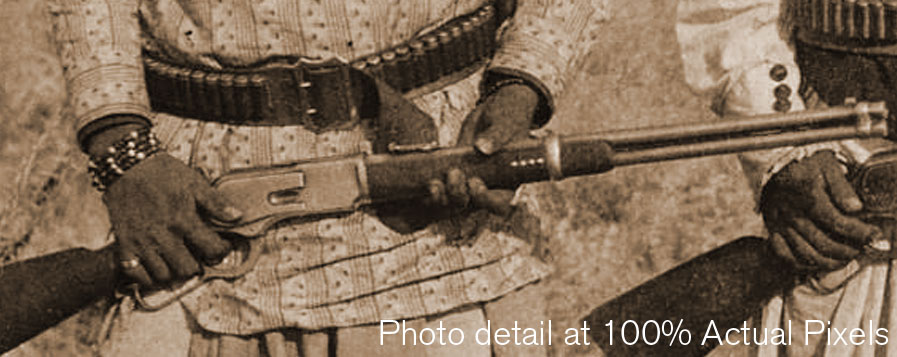
I am a commercial imaging expert and this is the best scan I could get of an original photograph. I am very happy with it and it looks quite impressive even at the larger print sizes.
I am set up in-house to print on an 8-color "Epson 7880" archival printer and print on professional "Epson Premium Luster" photo paper — this combination is very tough (I've soaked prints in water overnight and dried them off the next day with no color or water damage).
HOW LONG WILL THESE PRINTS LAST:
Industry professionals speculate the color on these prints will last 100-plus years with normal care (framed behind glass and out of direct sunlight, away from excessive heat and humidity as you would display any other expensive photographic artwork). I package the print to become a valuable family heirloom.
UNCONDITIONAL GUARANTEE:
I know what I am doing here and believe you will love your poster print as I do mine, so your purchase is guaranteed unconditionally and may be returned for any reason for one week after you receive it for a full refund as long as it is received here undamaged — check out the expert pixel and tonal quality:

COPYRIGHT NOTICE:
POSTER DESIGN © 2010 www.gballard.net - ALL RIGHTS RESERVED
You are welcome to download and print the above "Homeland Security" poster file for personal and educational use — it is a low print resolution (144 ppi) at 5x7 print size — it will become blurry at 8x10 and larger, but is good and sharp at the released 5x7 print size. Simply right+click on the poster image and Save Image to Desktop.
ABOUT THE PERSON WHO PRODUCED THIS WEB PAGE:
Professional Photoshop design and writing by Gary G. Ballard, San Diego, California.
Gary Ballard is a professional PHOTOJOURNALIST | WEBMASTER | BLOG MASTER | SEARCH ENGINE OPTIMIZATION SEO WRITER who specializes in creating high-quality original creative content that grabs attention and writing that hits search engine traffic.
Adobe® Photoshop® are registered trademarks of Adobe Systems Incorporated.
Terms of Use • Privacy Statement • Site Map • Kumeyaay Indians Research

